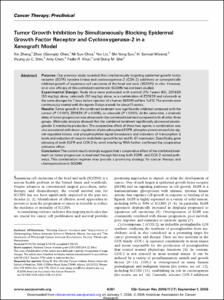Tumor Growth Inhibition by Simultaneously Blocking Epidermal Growth Factor Receptor and Cyclooxygenase-2 in a Xenograft Model
- Keimyung Author(s)
- Choe, Mi Sun
- Department
- Dept. of Pathology (병리학)
- Journal Title
- Clinical Cancer Research
- Issued Date
- 2005
- Volume
- 11
- Issue
- 17
- Abstract
- Purpose: Our previous study revealed that simultaneously targeting epidermal growth factor receptor (EGFR) tyrosine kinase and cyclooxygenase-2 (COX-2) additively or synergistically inhibited growth of squamous cell carcinoma of the head and neck (SCCHN) in vitro. However, an in vivo efficacy of this combined treatment in SCCHN has not been studied.
Experimental Design: Nude mice were pretreated with control (1% Tween 80), ZD1839 (50 mg/kg) alone, celecoxib (50 mg/kg) alone, or a combination of ZD1839 and celecoxib at the same dosages for 7 days before injection of a human SCCHN cell line Tu212. The animals were continuously treated with the agents 5 days a week for about 11 weeks.
Results: Tumor growth in the combined treatment was significantly inhibited compared with the control (P < 0.001), ZD1839 (P = 0.005), or celecoxib (P < 0.001). At the same time, a dramatic delay of tumor progression was observed in the combined treatment compared with all other three groups. Molecular analysis showed that the combined treatment significantly decreased prostaglandin E metabolite production. The cooperative effect of these two agents in combination was also associated with down-regulation of phosphorylated EGFR, phosphorylated extracellular signal-regulated kinase, and phosphorylated signal transducers and activators of transcription 3 levels and reduction of vascular endothelial growth factor and Ki-67 expression. Specifically, gene silencing of both EGFR and COX-2 by small interfering RNA further confirmed the cooperative antitumor effect.
Conclusion: The current results strongly suggest that a cooperative effect of the combined treatment on tumor progression is mediated through blocking both EGFR- and COX-2-related pathways. This combination regimen may provide a promising strategy for cancer therapy and chemoprevention in SCCHN.
- Keimyung Author(s)(Kor)
- 최미선
- Publisher
- School of Medicine
- Citation
- Xin Zhang et al. (2005). Tumor Growth Inhibition by Simultaneously Blocking Epidermal Growth Factor Receptor and Cyclooxygenase-2 in a Xenograft Model. Clinical Cancer Research, 11(17), 6261–6269. doi: 10.1158/1078-0432.CCR-04-2102
- Type
- Article
- ISSN
- 1078-0432
- Appears in Collections:
- 1. School of Medicine (의과대학) > Dept. of Pathology (병리학)
- 파일 목록
-
-
Download
 oak-aaa-01485.pdf
기타 데이터 / 1.17 MB / Adobe PDF
oak-aaa-01485.pdf
기타 데이터 / 1.17 MB / Adobe PDF
-
Items in Repository are protected by copyright, with all rights reserved, unless otherwise indicated.